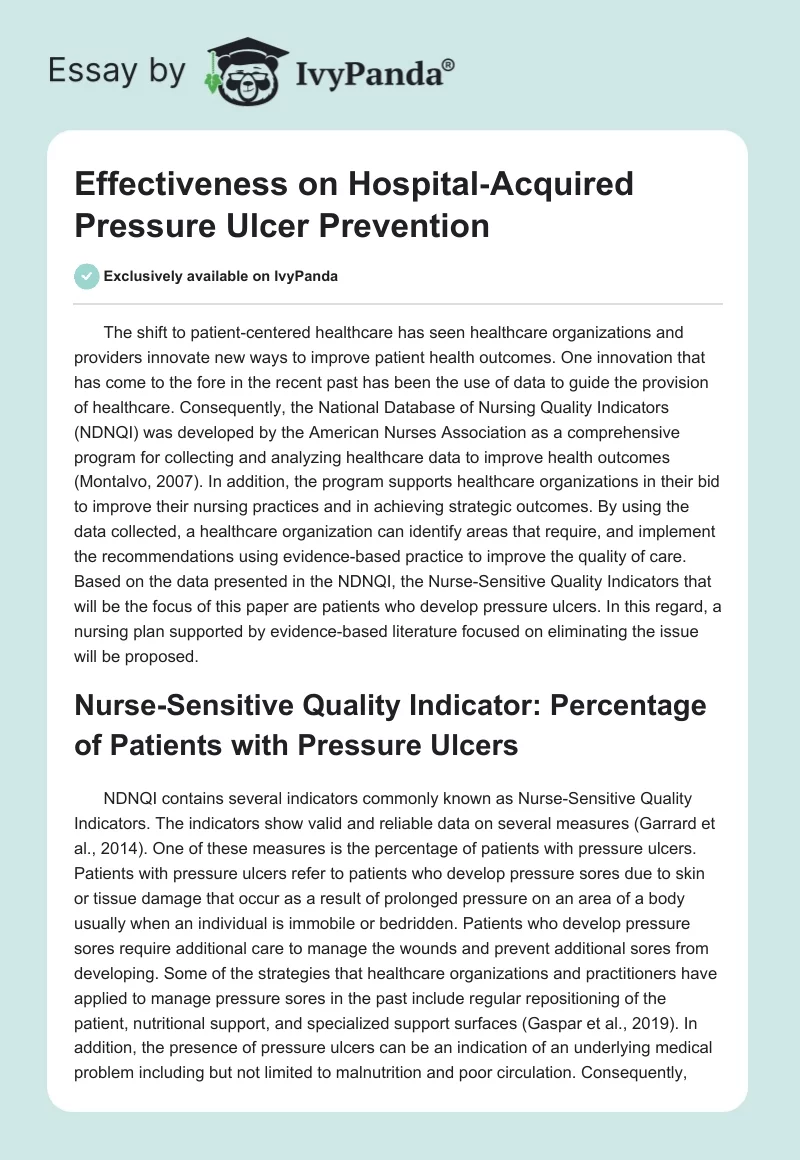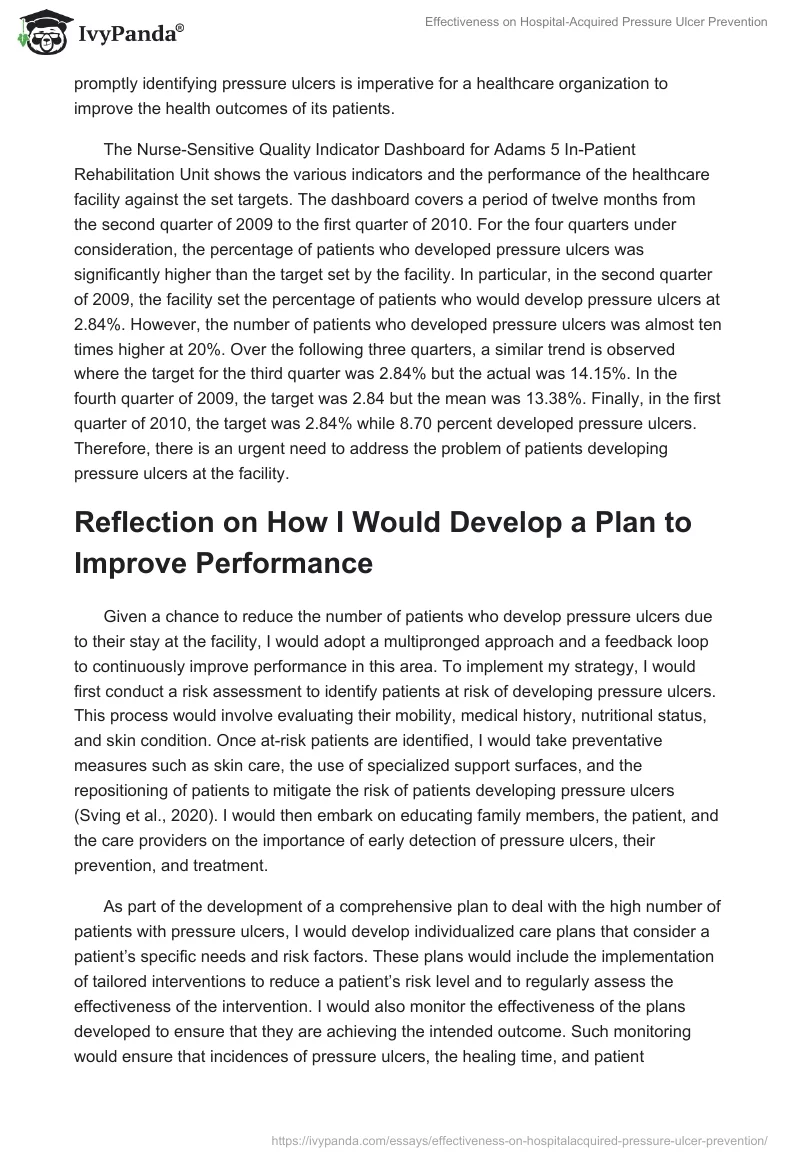The shift to patient-centered healthcare has seen healthcare organizations and providers innovate new ways to improve patient health outcomes. One innovation that has come to the fore in the recent past has been the use of data to guide the provision of healthcare. Consequently, the National Database of Nursing Quality Indicators (NDNQI) was developed by the American Nurses Association as a comprehensive program for collecting and analyzing healthcare data to improve health outcomes (Montalvo, 2007). In addition, the program supports healthcare organizations in their bid to improve their nursing practices and in achieving strategic outcomes. By using the data collected, a healthcare organization can identify areas that require, and implement the recommendations using evidence-based practice to improve the quality of care. Based on the data presented in the NDNQI, the Nurse-Sensitive Quality Indicators that will be the focus of this paper are patients who develop pressure ulcers. In this regard, a nursing plan supported by evidence-based literature focused on eliminating the issue will be proposed.
Nurse-Sensitive Quality Indicator: Percentage of Patients with Pressure Ulcers
NDNQI contains several indicators commonly known as Nurse-Sensitive Quality Indicators. The indicators show valid and reliable data on several measures (Garrard et al., 2014). One of these measures is the percentage of patients with pressure ulcers. Patients with pressure ulcers refer to patients who develop pressure sores due to skin or tissue damage that occur as a result of prolonged pressure on an area of a body usually when an individual is immobile or bedridden. Patients who develop pressure sores require additional care to manage the wounds and prevent additional sores from developing. Some of the strategies that healthcare organizations and practitioners have applied to manage pressure sores in the past include regular repositioning of the patient, nutritional support, and specialized support surfaces (Gaspar et al., 2019). In addition, the presence of pressure ulcers can be an indication of an underlying medical problem including but not limited to malnutrition and poor circulation. Consequently, promptly identifying pressure ulcers is imperative for a healthcare organization to improve the health outcomes of its patients.
The Nurse-Sensitive Quality Indicator Dashboard for Adams 5 In-Patient Rehabilitation Unit shows the various indicators and the performance of the healthcare facility against the set targets. The dashboard covers a period of twelve months from the second quarter of 2009 to the first quarter of 2010. For the four quarters under consideration, the percentage of patients who developed pressure ulcers was significantly higher than the target set by the facility. In particular, in the second quarter of 2009, the facility set the percentage of patients who would develop pressure ulcers at 2.84%. However, the number of patients who developed pressure ulcers was almost ten times higher at 20%. Over the following three quarters, a similar trend is observed where the target for the third quarter was 2.84% but the actual was 14.15%. In the fourth quarter of 2009, the target was 2.84 but the mean was 13.38%. Finally, in the first quarter of 2010, the target was 2.84% while 8.70 percent developed pressure ulcers. Therefore, there is an urgent need to address the problem of patients developing pressure ulcers at the facility.
Reflection on How I Would Develop a Plan to Improve Performance
Given a chance to reduce the number of patients who develop pressure ulcers due to their stay at the facility, I would adopt a multipronged approach and a feedback loop to continuously improve performance in this area. To implement my strategy, I would first conduct a risk assessment to identify patients at risk of developing pressure ulcers. This process would involve evaluating their mobility, medical history, nutritional status, and skin condition. Once at-risk patients are identified, I would take preventative measures such as skin care, the use of specialized support surfaces, and the repositioning of patients to mitigate the risk of patients developing pressure ulcers (Sving et al., 2020). I would then embark on educating family members, the patient, and the care providers on the importance of early detection of pressure ulcers, their prevention, and treatment.
As part of the development of a comprehensive plan to deal with the high number of patients with pressure ulcers, I would develop individualized care plans that consider a patient’s specific needs and risk factors. These plans would include the implementation of tailored interventions to reduce a patient’s risk level and to regularly assess the effectiveness of the intervention. I would also monitor the effectiveness of the plans developed to ensure that they are achieving the intended outcome. Such monitoring would ensure that incidences of pressure ulcers, the healing time, and patient satisfaction are improved (Sving et al., 2020). Finally, I would advocate for the implementation of quality improvement initiatives. Consequently, data collected for NDNQI would be utilized to reduce the incidence of pressure ulcers at the facility.
Nursing Plan on How to Reduce Pressure Ulcers Incidences
Incidences of pressure ulcers at the facility can be reduced or eliminated through the implementation of well-orchestrated evidence-based strategies including the risk assessment of patients admitted at the facility, the development and implementation of individualized care plans for at-risk patients, and educating patients, family members, and care providers on the importance of prevention of pressure ulcers, early detection, and treatment (Khojastehfar et al., 2020). The first evidence-based best practice to reduce pressure ulcers is the implementation of a risk assessment mechanism that evaluates the likelihood of a patient developing pressure ulcers. Such a mechanism must assess the patient’s mobility, medical history, nutritional status, and skin condition (Moore et al., 2020). Through this mechanism, patients are classified as at-risk, and those whose risk is relatively low and manageable.
The second evidence-based best practice to reduce pressure ulcers at the facility is developing and implementing individualized care plans for patients who have been classified as at-risk of developing pressure ulcers. The individualized care plans can include the repositioning of the patients to prevent pressure on bony prominences (Mervis & Tania, 2017). The frequency of repositioning may vary depending on the patient although evidence suggests that it should be done every two hours. It should also include the use of specialized support surfaces to distribute pressure and prevent it from accumulating in one area. The last part of individualized care is skin care which can include cleaning, moisturizing, and protecting the skin. The final strategy in the plan is educating the patient, family members, and care providers. Such a strategy would include education on early detection, prevention, and treatment of pressure ulcers.
Conclusion
From the analysis of the NDNQI, it is apparent that it provides important insight that a healthcare facility can use to improve patient outcomes. In this case, the data in NDNQI shows that the percentage of pressure ulcers at Adams 5 In-Patient Rehabilitation Unit was significantly higher than the target percentage. In this regard, it was necessary to develop a nurse plan to reduce it to the target level. The plan involved risk assessment of patients at the facility, the development and implantation of individualized care plans for high-risk patients, and educating the patient, family members, and caregivers on the importance of early detection and treatment of pressure ulcers. The proposed plan is based on evidence-based literature on the condition and how well to treat and manage it to improve patient outcomes.
References
Garrard, L., Boyle, D. K., Simon, M., Dunton, N., & Gajewski, B. (2014). Reliability and validity of the NDNQI® Injury Falls Measure. Western Journal of Nursing Research, 38(1), 111–128. Web.
Gaspar, S., Peralta, M., Marques, A., Budri, A., & Gaspar de Matos, M. (2019). Effectiveness on hospital‐acquired pressure ulcers prevention: A systematic review. International Wound Journal, 16(5), 1087–1102. Web.
Khojastehfar, S., Najafi Ghezeljeh, T., & Haghani, S. (2020). Factors related to knowledge, attitude, and practice of nurses in intensive care unit in the area of pressure ulcer prevention: A multicenter study. Journal of Tissue Viability, 29(2), 76–81. Web.
Mervis, J., & Tania, P. (2019). Pressure ulcers: Prevention and management. Journal of the American Academy of Dermatology, 81(4), 893–902. Web.
Montalvo, I. (2007). The National Database of Nursing Quality Indicators® (NDNQI®). OJIN: The Online Journal of Issues in Nursing, 12(3). Web.
Moore, Z., Patton, D., Avsar, P., McEvoy, N. L., Curley, G., Budri, A., Nugent, L., Walsh, S., & O’Connor, T. (2020). Prevention of pressure ulcers among individuals cared for in the prone position: Lessons for the covid-19 emergency. Journal of Wound Care, 29(6), 312–320. Web.
Sving, E., Fredriksson, L., Mamhidir, A.-G., Högman, M., & Gunningberg, L. (2020). A multifaceted intervention for evidence-based pressure ulcer prevention. International Journal of Evidence-Based Healthcare, Publish Ahead of Print. Web.


